The Intel Broadwell Desktop Review: Core i7-5775C and Core i5-5675C Tested (Part 1)
by Ian Cutress on June 2, 2015 7:45 AM EST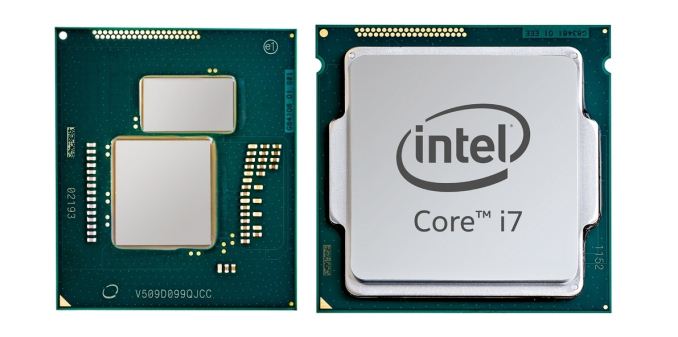
On almost all PC technology forums, it is hard to escape users talking about what Intel’s next processor lineup will be. Due to initial yield issues in Intel’s 14nm node, Broadwell in both mobile and desktop ended up being delayed, somewhat substantially in the case of the desktop. So while motherboard manufacturers released their Z97 platform over 6 months ago, we have been waiting for Broadwell to arrive. That day is today, and we can lay the smackdown with some benchmark numbers too.
The Road to Broadwell
Broadwell, in its top level explanation, is the 14nm die shrink of Haswell which was built on 22nm. Using Intel’s 14nm process this results in a smaller silicon die and lower power consumption. Frequency will depend on the architecture and if the process is suited to frequency or power, but the CPU core underneath is still more-or-less Haswell, with some minor tweaks of course.
As part of Intel’s tick-tock strategy, this would be considered a tick:
| Intel's Tick-Tock Cadence | |||||
| Microarchitecture | Process Node | Tick or Tock | Release Year | ||
| Conroe/Merom | 65nm | Tock | 2006 | ||
| Penryn | 45nm | Tick | 2007 | ||
| Nehalem | 45nm | Tock | 2008 | ||
| Westmere | 32nm | Tick | 2010 | ||
| Sandy Bridge | 32nm | Tock | 2011 | ||
| Ivy Bridge | 22nm | Tick | 2012 | ||
| Haswell | 22nm | Tock | 2013 | ||
| Broadwell | 14nm | Tick | Core-M: 2014 Others: 2015 |
||
If history tells us anything, ticks are usually accompanied by small IPC increases, resulting in 5-10% better performance depending on the benchmark, but ultimately ticks still follow the same capabilities of the processor before them. Intel usually uses its ticks to introduce a new chipset with a large number of capabilities, which we saw with Z97 and its use of M.2/SATA Express on the chipset. If the classical idea of a three year cycle between upgrades is true, then back in the summer of 2012, we were playing around with Ivy Bridge, the tick to Sandy Bridge.
The Broadwell Launch
Back in mid 2014, Intel launched Core M, the first 14nm processor in the mass market and the first Broadwell based product. Core M is the official marketing designation for what was historically the Y series processor (Broadwell-Y), but Core M played a different role to other Y series processors. Core M brought the Core architecture down to a 4.5W thermal design, enabling small and thin fanless 2-in-1 laptop/tablet designs. When the first products started appearing around Christmas and CES, we tested a few and even got down and dirty with the questions that OEMs had to answer with their own chassis designs.
At CES (January 2015), Intel launched Broadwell-U. These devices are aimed more at traditional laptops, mini-PCs and all-in-ones, with the lower-wattage SKUs targeting devices in the 15W range. At the same time higher power 28W SKUs were also announced, with the graphics gamut migrating through the basic Gen 8 package up to Crystal Well based Iris Pro, using onboard EDRAM as an additional cache to improve graphics performance.
After Y and U in Intel’s naming scheme typically comes H, representing higher power (47W-65W) mobile processors or ones suitable for all-in-one type desktop replacement devices which are, for the most part, stationary. H processors are favorites in business due to their high performance, but typically these devices also require large batteries and can come with large (15-17”) screens. They are all soldered down parts as well. Technically some of the H processors are part of the launch today.
After Y, U and H is somewhat of a miasma. The processor lineup, depending on who you speak to, might be DT, S, T, or K. Some of these are also used in the processor names themselves, but we will use Broadwell-DT for consistency. Normally an Intel desktop processor lineup spans a gamut of SKUs, from Celerons, Pentiums, i3, i5 and up to i7. Some ranges consist of 50 or so SKUs, whereby one segment (i5/i7, for example) are launched first and the rest are launched later.
That brings us to today. All-told, Intel is launching ten different SKUs, five 47W laptop and five 65W 'desktop', using a mix of socketed (LGA) and soldered (BGA) parts. All five desktop SKUs are still technically Broadwell-H, and all five are 65W quad-core models featuring Intel's Iris Pro integrated graphics and the product's associated Crystal Well L4 cache. Meanwhile in an interesting turn of events, the two socketed models will be breaking the mold by becoming the first H-family processors to be socketed. These will be the parts we're looking at today.
The Effect of TDP
If we move back to those large processor stacks, Intel tends to produce a range of products from 15W TDP (extreme low power Xeon) through 35W, 55W and up to 84-88W for consumer then 160W for Xeon. Sticking with the consumer line for the moment, the high end overclocking models have recently sat in that 84-88W bracket, donning the i5-K or i7-K moniker and being some of the most talked about processors on forums and for custom builds. Broadwell changes this, and a lot of users might not expect it to.
Because the top Broadwell-DT SKUs are based on Intel's Broadwell-H design, both of the these SKUs ship with a TDP of 65W. As a result, frequencies on the cores are lower, and it means that these processors are best suited for comparison to 65W Haswell processors, such as the i7-4790S or i5-4590S, rather than the i7-4770K or i7-4790K. Thus users looking to upgrade their i5-K or i7-K might be wondering where their 84W processor is.
But both Broadwell-DT processors are overclockable, which adds an element of intrigue. I’ll speak specifically about the Crystal Well implementation in a second, but whether having that extra eDRAM on board effect overclocking is going to be a poignant question moving forward. If a 4.6 GHz Haswell user can also achieve 4.6 GHz on Broadwell, then the benefit of any IPC increase along with the eDRAM might be a driver for purchase. Unfortunately althugh both of the socketed chips are unlocked, due to both time constraints and severe pre-release firmware issues, we're going to have to save overclocking on Broadwell-DT for Part 2 of our coverage.
Integrated Graphics
Intel announced several months ago that Broadwell would be getting the first socketed processor with a Crystal Well implementation that would also be overclockable. For a number of us in the industry, this piqued our interest substantially. Crystal Well, Intel’s name for CPUs that carry extra eDRAM, offers the potential to alleviate DRAM pressure by acting as an L4 cache, but also gives more memory bandwidth for integrated graphics. Given that integrated graphics are typically memory starved to begin with, Crystal Well when announced was an interesting prospect. Unfortunately, for Haswell based models, Intel limited the project to soldered processors only, which meant there was no possible direct desktop comparison. This changes with Broadwell-DT.
Aside from this, in terms of integrated graphics only usage, Broadwell-DT has a full GT3e configuration of execution units that a Broadwell processor has been announced to have. On Core-M we see 24 EUs, Atom x7 with 16, Pentium/Celeron Broadwell-U has 12, while there are various models with 23 or 24 EUs in the Broadwell-U i3/i5 and i7 lines and a few Broadwell-U models with the full 48 EUs with Iris Pro 6100. There will be some Broadwell-H models with 48, which is the number that Broadwell-DT models with the designation ‘C’ or ‘R’ will have.
The current king of the socketed integrated graphics world is AMD’s A10-7870K, which we recently reviewed. Broadwell-DT with Crystal Well is going after that crown.


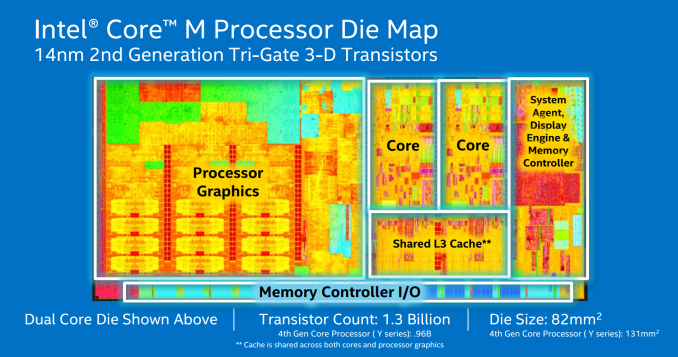
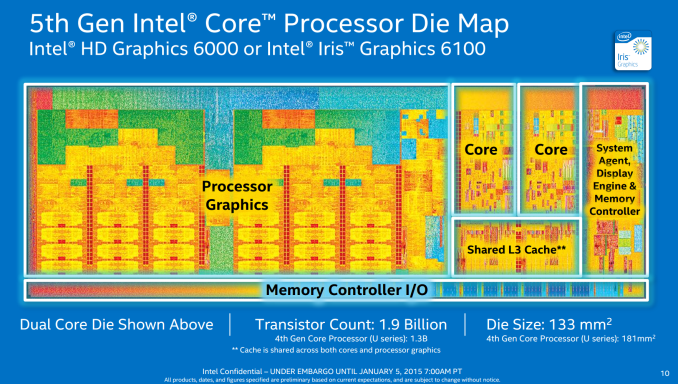
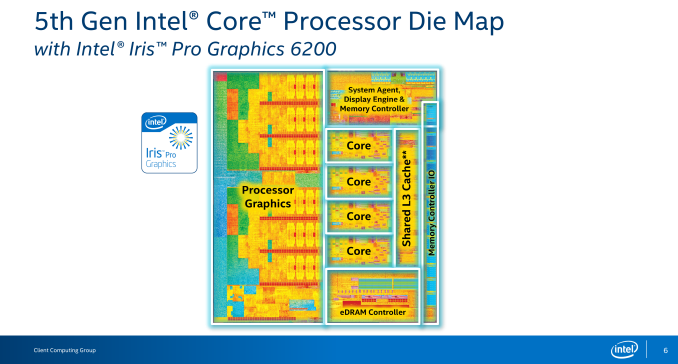
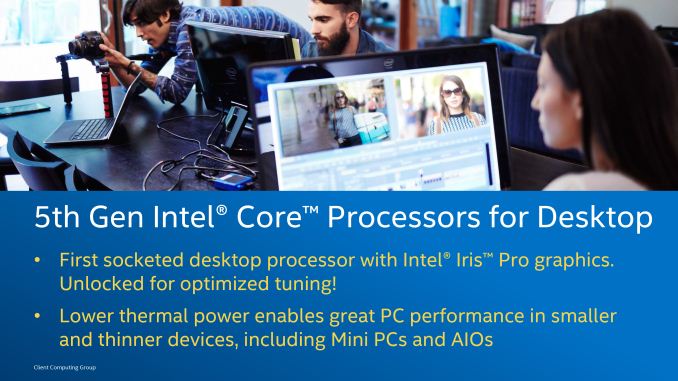
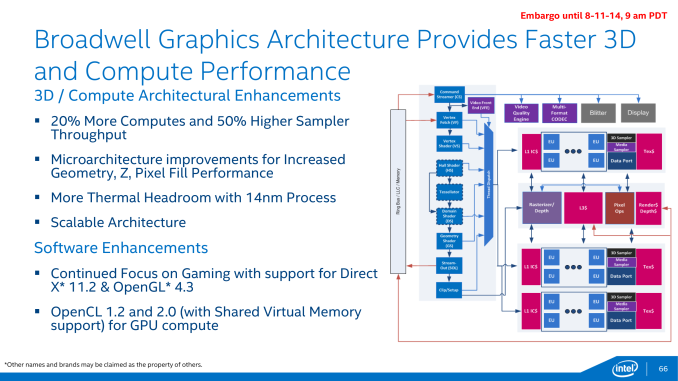








196 Comments
View All Comments
MrSpadge - Tuesday, June 2, 2015 - link
Simply use something representative of the current situation. Not old numbers which may be totally meaningless today. In Europe we have simple price comparison engines like geizhals.eu where it's really easy to find typical prices. Just exclude obvious outliers and cheap products not yet deliverable and voila, you've got the current street price.nathanddrews - Tuesday, June 2, 2015 - link
In Europe? You mean on the Internet? LOLThere are tons of price comparison websites, but why should AT take the time and be responsible for tracking down pricing when we can all do that in our own areas or from our favorite retailers? They don't know where I like to shop or what currency I use, so it seems like a waste of their time. I'd much rather get quality performance analyses on a more regular basis than have them worry about updating price indexes. Who knows? Maybe their new parent company can do that for them off to the side or something?
MrSpadge - Wednesday, June 3, 2015 - link
I never see people from the US referring to them. They seem to just use Newegg or Amazon. And getting prices for European shops won't do AT any good, as they're mainly writing for the US.And AT has to look up the launch prices of the hardware anyway when they write a review. How much more time would it take to instead look up the current price in a comparison engine? Again, I'm not talking about updating prices dynamically.
I they're not doing this you always get comments like "who in their right mind would buy x? Vendor y must be totally stupid to keep offering this". Simply because the launch price is far higher than the current price.
Senpuu - Wednesday, June 3, 2015 - link
Why should AT take the time, you asked? Well, why should they list a price at all then? Hell, why provide any information to the reader beyond specs and performance metrics? Why even talk about the market at all? There is obviously value to be had in doing so and it comes down to where you draw the line. Whereas you would rather they not 'waste their time', I would rather not waste mine by having to question whether a product is being valued near current market price or some esoteric launch price, and then being forced to google multiple things myself to get a feel for 'real world' prices. No, the price they come to will likely not tell me the exact total of the item in question at whatever preferred retailer a reader happens to use, but it will probably be within 5-10% of that value, which is highly useful for at-a-glance comparisons and understanding where something sits in a market segment.We're not talking about a large amount of effort here, but I'd rather AT do it than myself; it's less effort for them and it benefits a large portion of their readers. Simply provide a disclaimer about the methods used to gather the data as well as a liability warning, and everyone's happy.
Thud2 - Saturday, June 13, 2015 - link
Very good point.yannigr2 - Wednesday, June 3, 2015 - link
There are official price cuts and so you have new OFFICIAL pricing that it is fair to put in the charts. If the launch price of 7850K was $500 and the last official price was $100, wouldn't be the above charts completely misleading? People do have a price/performance ratio in their minds when looking at these charts. In fact for 90% that's the biggest parameter when looking at those charts. And those charts LIE exactly there.manifestation88method - Sunday, September 27, 2020 - link
Nice post https://discoversoulpath.com/yannigr2 - Wednesday, June 3, 2015 - link
You can always take the last OFFICIAL price, but nevermind. It's AMD's pricing that it is wrong anyway. Who cares about poor poor AMD?Gothmoth - Tuesday, June 2, 2015 - link
intel is sitting on it´s laurels because there is no competition.AMD is no competition for poweruser.
users want broadwell..mhm.. aha....
i am the only one who wants intel to make a fast 6 (or better 8) core system without integrated graphics, that runs not to hot and does not cost a fortune?
can´t we have such a CPU for 500-600 euro?
ok then i stick to my OC ivy bridge for a few more years.. and you intel can complain about declining sales.
MrSpadge - Tuesday, June 2, 2015 - link
That's exactly what i7-5820K is for. If it consumes too much power for your taste - well, that's simply the price you have to pay for more cores.